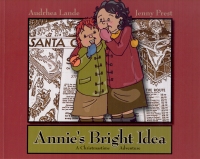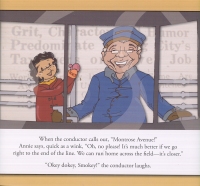| ________________
CM . . .
. Volume XVII Number 13. . . .November 26, 2010 
 |
Annie’s Bright Idea: A Christmastime Adventure.
Audrhea Lande. Illustrated by Jenny Prest.
Regina, SK: Your Nickel’s Worth Publishing, 2010.
32 pp., pbk., $14.95.
ISBN 978-1-894431-54-5.
Subject Heading:
Christmas stories, Canadian (English).
Kindergarten-grade 3 / Ages 5-8.
Review by Harriet Zaidman.
**** /4 |
| |
|

excerpt:
Squeezing their way through the crowds at the doorway, they push open the heavy doors and gasp with wonder. A sparkling tree. Fancy ladies in fur coats. A giant golden statue of a man on a throne. “Holy moley,” says Annie, “let’s go see everything – Santa can wait!”
…And oh! The heavenly candy counter! Layered stacks of coconut marshmallows, bins of sugary gumdrops, hard bright ribbon candy for Christmas. Annie licks her lips all around and makes smacking sounds. Olly runs to each bin, sniffing the wonderful sweet smells.
Oh, how they want some!
But Relief children have no pennies for candy. They stand there a long time, wishing.
Christmases past are recalled in this tale of two sisters looking for Santa in Depression era Winnipeg. First-time author and self-publisher Audrhea Lande has written a story inspired by her mother’s experience as a child.
 Lande has “listened to her mother” and done thorough research that is reflected in characters with authentic voices. Illustrator Jenny Prest adds to the richness of the text with illustrations that make the pages become objects of study, where the reader learns about the girls’ journey and how the world looked, as well as the news of the day. Lande has “listened to her mother” and done thorough research that is reflected in characters with authentic voices. Illustrator Jenny Prest adds to the richness of the text with illustrations that make the pages become objects of study, where the reader learns about the girls’ journey and how the world looked, as well as the news of the day.
The story is set in November 1933, one of the lowest points in the Depression. But hope springs eternal in youth. Nine-year-old Annie wakes her sister Ollie (Olga – Lande’s mother) and declares they’re going to find Santa together (no parental supervision then, and plenty of secrets between siblings). The girls walk from their Elmwood home to the Eaton’s store downtown, no small distance. Eaton’s was a Mecca of Merchandise, the iconic department store that sold everything from underwear to pre-fabricated homes in those days. En route, a hobo saves them from danger on a railway bridge.
Inside the store, Annie and Ollie spend an thrilling day riding the escalators and elevators, ogling at the people, the brass statue of Timothy Eaton, Christmas decorations, toys and all the beautiful items for sale.
But it’s all ‘only for looking.’ They are Relief Children. Their parents are poor, like millions of people at that time, and the only way they may possibly get anything – even a single candy – is if they find a stray sweet.
Santa isn’t at the store that day, and Eaton’s is set to close. It’s getting dark, and the hungry girls realize they can’t remember the route home. A policeman helps out, enlisting a streetcar driver to give them a free ride.
In the course of the story, Lande introduces readers to the many different types of people the children would have encountered, from the ‘bum’ –a victim of the Stock Market Crash of 1929, to the cop wearing one of heavy buffalo coats issued to policemen walking the beat in winter. There’s also the friendly streetcar driver, whose “Okey dokey, Smokey” was part of the language, along with Annie’s “Holy moley”.
The reader also meets Ollie and Anna’s hardworking Ukrainian immigrant parents (Mamoo and Tahtoh), who want to punish them for taking off unannounced all day. The sisters escaped unscathed, and go to sleep in their shared bed, with memories of their adventure, as full of hope as when the day began.
Prest’s artwork shows research, thought and creativity. Annie and Ollie are drawn as Little Orphan Annie caricatures, with round faces, button noses and plenty of freckles. Their journey follows a tour of 1930’s Winnipeg, with photos of downtown Winnipeg and the Eaton’s building as sepia backdrops to the characters rendered in colour. Faint newspaper headlines and articles explain the times – when advertisements tempted little girls with promises of dolls that could close their eyes, and when unemployed men were herded into ‘relief camps’ in the wilderness to squelch social unrest. Each page is full of content but is carefully designed not to overwhelm the eye. A few carefully placed balloons add further information, including how Mamoo made dolls from wooden clothespins for her children.
Although families with children still receive Christmas hampers, food bank support and line up for free holiday meals, Annie’s Bright Idea shows the stark contrast to the holidays most children experience now. It is a happy book, lovingly told. It can educate children about Christmas, about Canada’s history during the Depression, and Winnipeg’s history, in particular, about how children ‘made do’ with nothing, and how they entertained themselves growing up. It’s a good book for adults to share with children – there is much to discuss and enjoy here.
Highly Recommended.
Harriet Zaidman is a teacher-librarian in Winnipeg, MB.
 To comment
on this title or this review, send mail to cm@umanitoba.ca.
To comment
on this title or this review, send mail to cm@umanitoba.ca.
Copyright © the Manitoba Library Association. Reproduction for personal
use is permitted only if this copyright notice is maintained. Any
other reproduction is prohibited without permission.
NEXT REVIEW |
TABLE OF CONTENTS FOR THIS ISSUE
- November 26, 2010.
AUTHORS |
TITLES |
MEDIA REVIEWS |
PROFILES |
BACK ISSUES |
SEARCH |
CMARCHIVE |
HOME |
|

 Lande has “listened to her mother” and done thorough research that is reflected in characters with authentic voices. Illustrator Jenny Prest adds to the richness of the text with illustrations that make the pages become objects of study, where the reader learns about the girls’ journey and how the world looked, as well as the news of the day.
Lande has “listened to her mother” and done thorough research that is reflected in characters with authentic voices. Illustrator Jenny Prest adds to the richness of the text with illustrations that make the pages become objects of study, where the reader learns about the girls’ journey and how the world looked, as well as the news of the day.